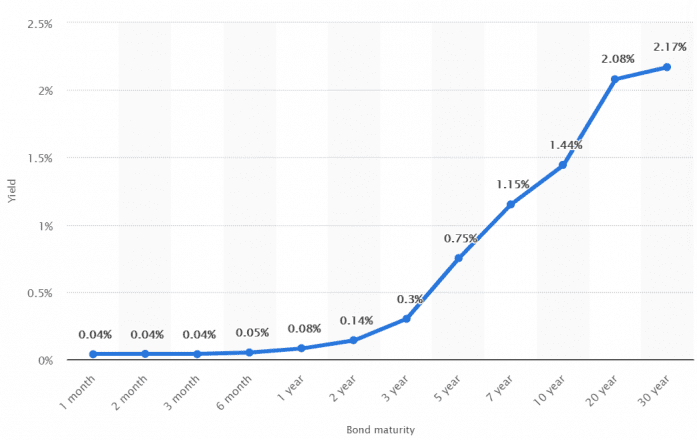Bitcoin, Gold, Stocks Rebound With Drop in U.S. Dollar
Various markets have seen their trends shift alongside Bitcoin's own changes.

Key Takeaways
- Bitcoin prices are on an upward trend this week.
- Several other markets including the gold, bond, and stock markets are interrelated with its performance.
- The Biden administration's decision to introduce a new stimulus package could also affect the crypto market.
Share this article
Bitcoin and technology stocks rallied this week, recouping from losses due to rising bond rates. Along with changes in the bond and gold markets and new upcoming stimulus rounds, there are five important macroeconomic movements affecting Bitcoin.
The Bond Market
On a global macro-level, Bitcoin’s positive outlook began with the strong resilience against the “reflation trade” in bond markets.
The market can track the reflation trade using the yield curve indicator, which measures the difference between long-term bond yields and short-term contracts. A steeper yield curve indicates the market’s expectations of high inflation in the future.
The bond market’s ten-year-yield has tripled from a low of 0.52% in August. Additionally, short-term expectations are still low due to the prevalent effects of COVID-19 shock. Hence, rising yields have threatened to move value away from other assets into bonds.

The U.S. Stimulus and Inflation
In the United States, the Biden administration is days away from ratifying a third economic stimulus package of $1.9 trillion. The government passed $3.4 trillion worth of stimulus packages in 2020.
The new stimulus round is likely to spark inflationary fears. However, the U.S. dollar has been in an uptrend thanks to the rising yields of long-term bonds. The dollar index (DXY) against other fiat currencies broke above the $90.50 resistance to a high of $92.50.
However, DXY corrected this morning by 0.28% after bond market sell-offs slowed down. Liquidity is now flowing out from the dollar again, which has restarted the devaluation trade.
The Gold Market
Markets have given mixed signals regarding inflation expectations. While bond markets are expecting inflation, the price action of gold shows no worrying signals.
Gold, the world’s oldest inflationary hedge, has been on a downward trend, losing support at $1790 per ounce to lows of $1675.
Gold’s price action is a reaction to the bond markets and the beginning of the reflationary trade. It represents a market exposed to faster economic growth, price pressures, and higher yields in an attempt to revive from an economic crisis.
Nevertheless, gold prices gained 2% this morning to reach a high of $1720, so there is some reason for optimism.
The Stock Market
The correlation between Bitcoin and the stock market increased towards the end of February. The U.S. dollar’s strength from the bond markets hurt stocks and Bitcoin’s value in early March. On Friday, stocks and Bitcoin dropped after Powell’s speech after he took a “dovish” stance towards the rising bond yields.

This morning, NASDAQ composite index and S&P 500 index were trading in the green along with BTC. NASDAQ’s stock (NDAQ) has risen by 9.5% after closing last week at a new all-time high of $149.50.
Bitcoin defied gravity during the reflation narrative. The alpha cryptocurrency has regained $1 trillion market capitalization with a price pushing towards $55,000.
In the absence of a negative catalyst, the uptrend is likely to continue for stocks and Bitcoin.
The Reflation Narrative
Fears around Bitcoin’s unprecedented rise have raised concerns about the possibility that the asset is in a “bubble,” and the possibility that the deviation from the institutional investment narrative when it doesn’t react to interest rates.
after much soul searching, i’ve decided the bitcoin macro narrative is dumb
the bitcoin market doesn’t respond to rates LOL imagine being that obtuse
in a number go up environment bitcoin is just another number go up to most allocators they just dress it up with pretty words
— Meltem Demirors (@Melt_Dem) March 3, 2021
Alex Kruger, an independent analyst, told Crypto Briefing that concerns are unwarranted, noting that “an object can move against the wind for as long as the wind is not too strong.”
According to Kruger, there is more than one force affecting Bitcoin’s price right now. While the short-term movements in bond markets have created a headwind for Bitcoin investment among institutional investors, those forces could be temporary.
Disclosure: The author held Bitcoin at the time of press.
Share this article
